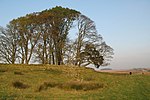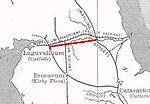Milecastle 33
Milecastles of Hadrian's Wall

Milecastle 33 (Shield on the Wall) was a milecastle of the Roman Hadrian's Wall, one of a series of small fortlets built at intervals of approximately one Roman mile along the length of the UNESCO World Heritage Site in northern England. Its remains exist as clearly visible earthworks, with the exception of part of the north gate and wall, and a fragment of the south gate, which are exposed. Exposed parts survive to a maximum height of 1.2 metres (3 ft 11 in) (north wall). The remains are located a few metres to the north of the B6318 Military Road.
Excerpt from the Wikipedia article Milecastle 33 (License: CC BY-SA 3.0, Authors, Images).Milecastle 33
Military Road,
Geographical coordinates (GPS) Address External links Nearby Places Show on map
Geographical coordinates (GPS)
| Latitude | Longitude |
|---|---|
| N 55.030867 ° | E -2.26611 ° |
Address
Milecastle 33 (Shield on the Wall)
Military Road
NE47 7AL , Newbrough
England, United Kingdom
Open on Google Maps










